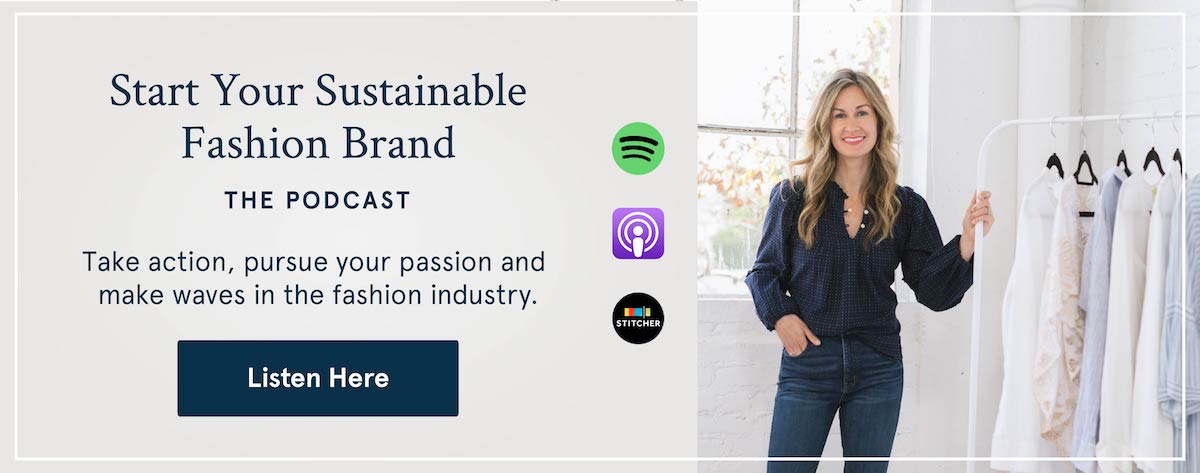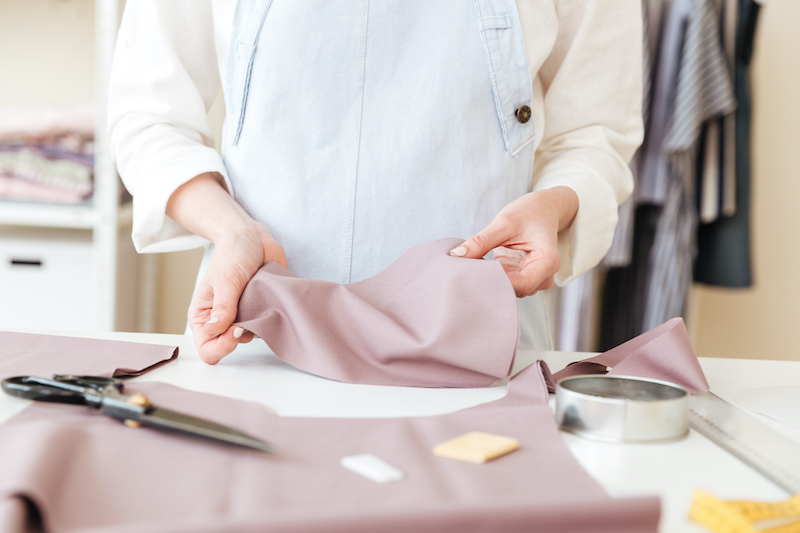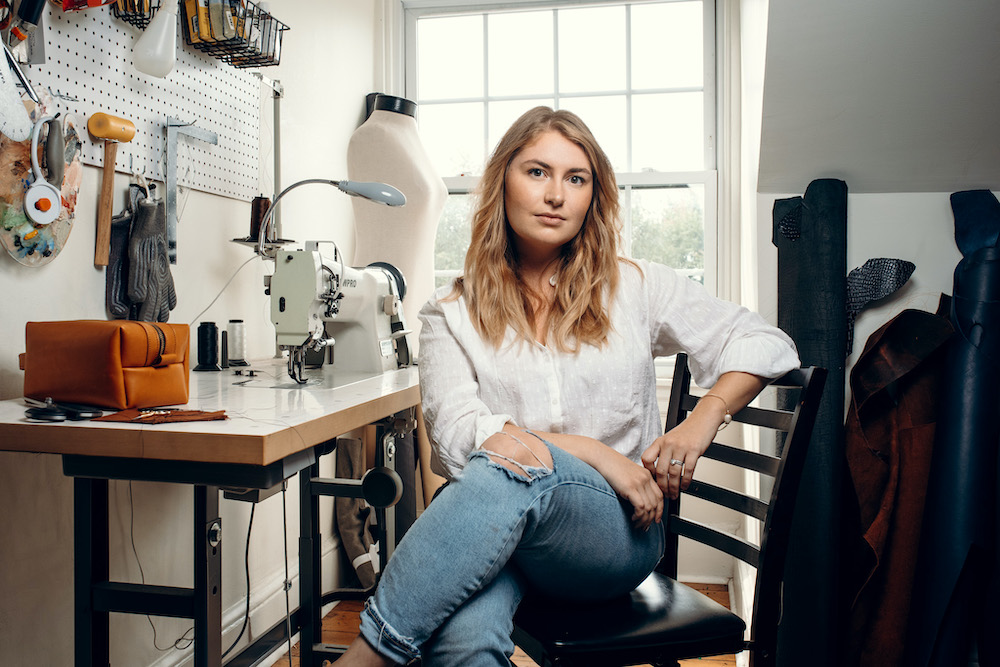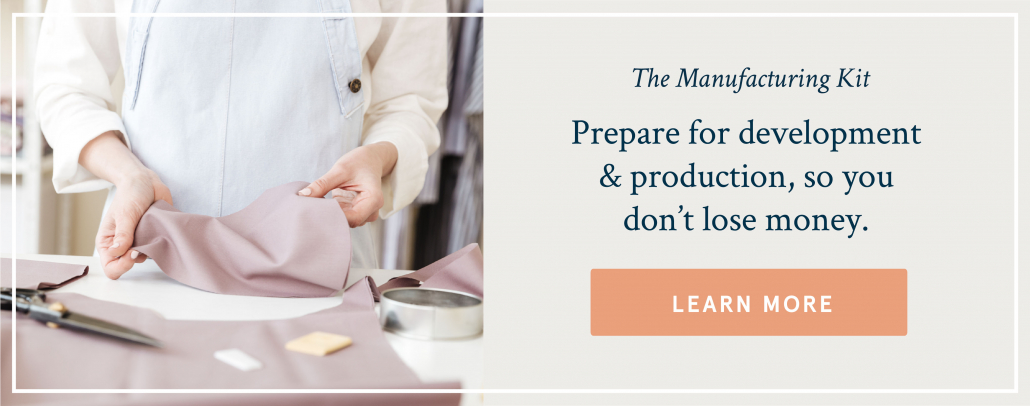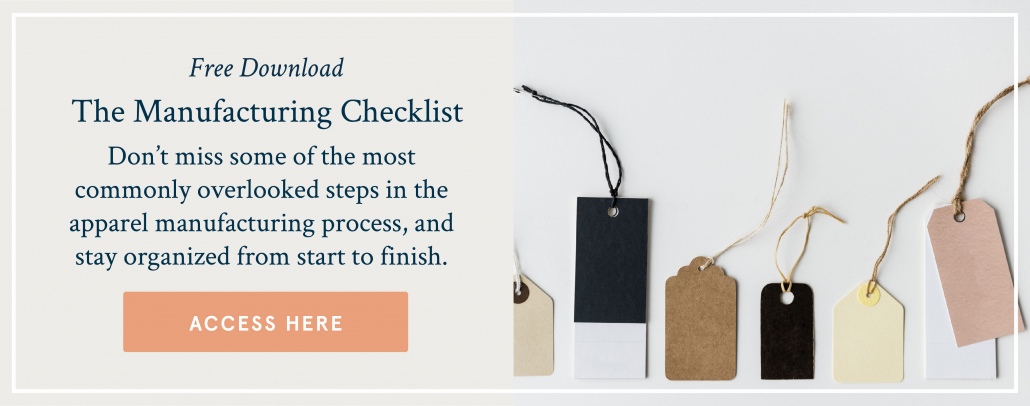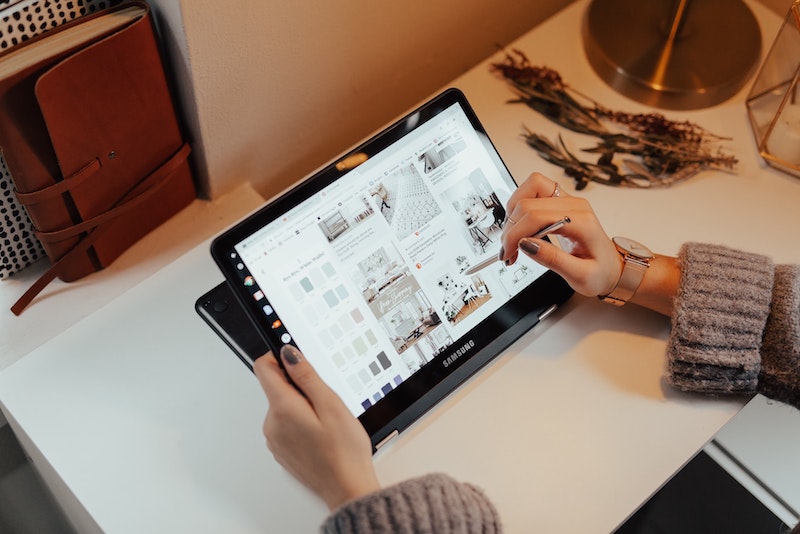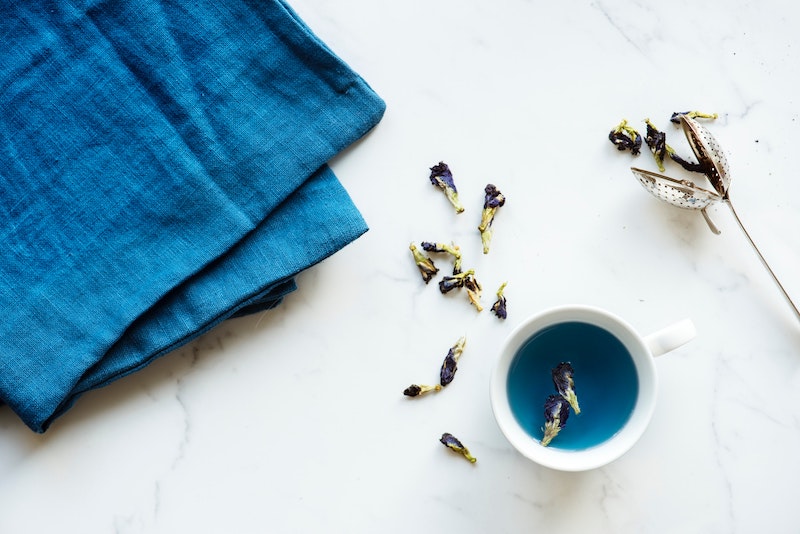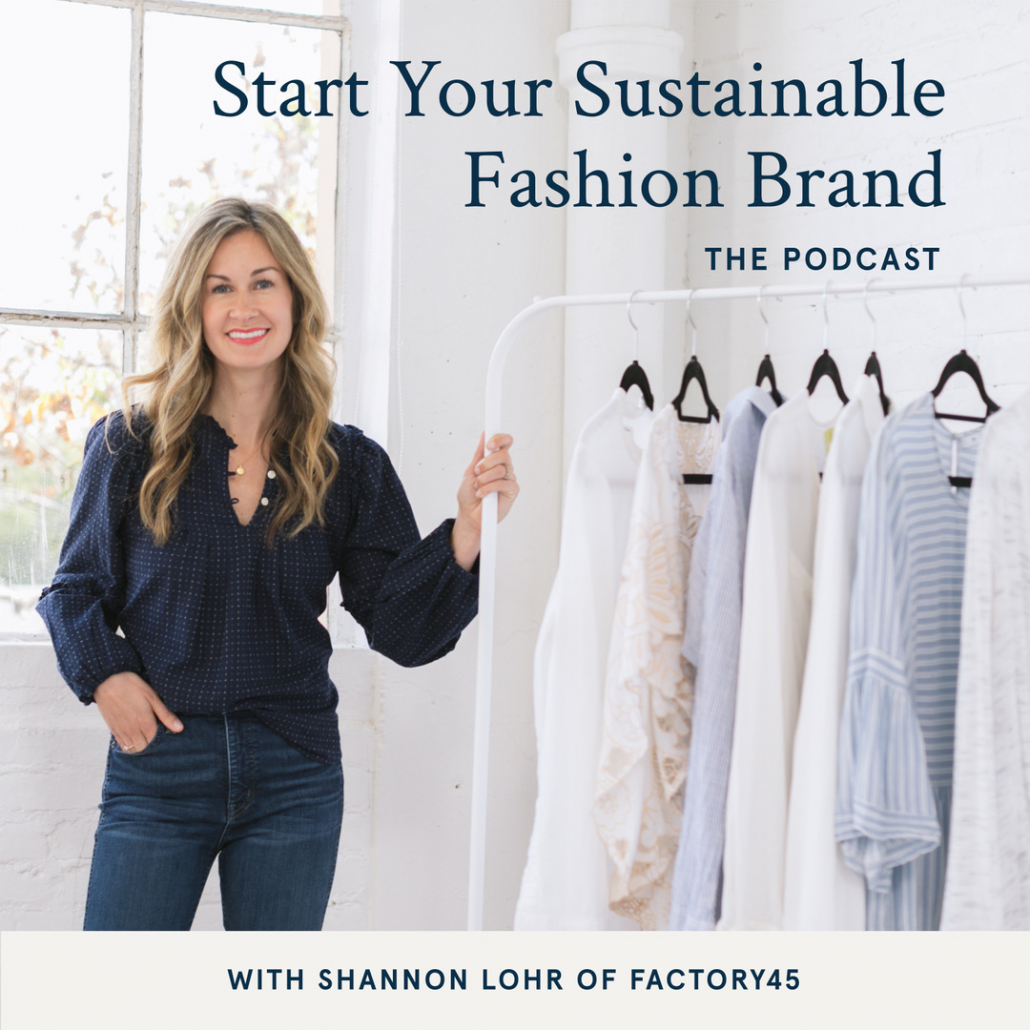Listen on Apple Podcasts | Listen on Spotify
Back in 2010, I was starting a fashion brand that was sustainably and ethically made in the USA but at the time, I didn’t have any experience in fashion or manufacturing. I was a journalism major in college, my then-cofounder was a business major so when we were first starting out we followed the traditional business advice…. And in this episode, I want to make sure you don’t make the same mistake.
Resources mentioned in this episode:
Free One Page Business Plan Template
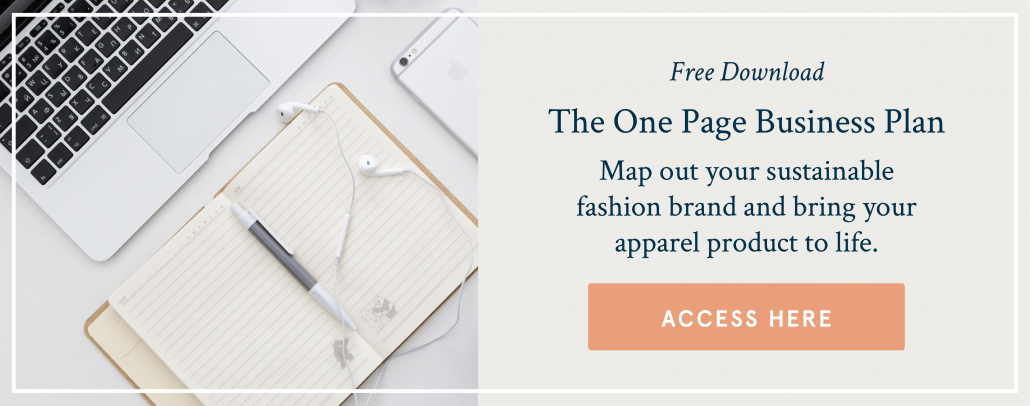
TRANSCRIPT
Back in 2010, I was starting a fashion brand that was sustainably and ethically made in the USA but at the time, I didn’t have any experience in fashion or manufacturing. I was a journalism major in college, my then-cofounder was a business major so when we were first starting out we followed the traditional business advice…. And in this episode, I want to make sure you don’t make the same mistake.
So when I was first starting out, the business advice we followed mainly came from my co-founder’s business degree and what our dads said we should do. The advice was that, before we did anything, we needed to write a business plan. I remember being in Nicaragua, visiting an organic cotton farm, before we even really had any sketches or designs on paper and sitting in the room of our hostel, opening a blank Word document and starting to write our business plan. I’m pretty sure we just followed a template or outline we found on Legal Zoom and then I remember going back to the United States a month later and still working on that same Word document.
By the time the business plan was done, it was 40 pages long and had taken us three months to write. And do you know what we did with it? We each sent copies of it to our parents. Not to investors or potential partners, not even to win a grant or get a business loan, the farthest that 40-page document ever got was to the email inboxes of our parents, — who maybe were proud of us but definitely did not read all 40 pages.
Here’s the truth that you probably won’t learn if you went to business school or took any traditional business courses, unless you’re pitching your brand to investors or applying for a bank loan, you 100% do not need a traditional long-form business plan.
We never used the business plan we wrote and instead, a few months later, we rewrote the original document into a simple one-page business plan that we could actually use. And that’s what I want to teach you in this episode. My goal is for you to have a one-page business plan for your fashion brand that you can continue to edit, tweak and adjust as you move forward and make progress. So for now, let’s start building the foundation.
If you have not already texted me to receive my free business plan template, then go ahead and do that now. Just text “business plan” to +1 (760) 274-8577 and we’ll get it sent over to you right now so you can follow along and fill it out on your own as I go. I really want you to go through this with me in real time, if you can, so that by the time this episode is over you will have the basics of your business plan written down in front of you. Think about how good that will feel, okay? So go ahead and click pause right now so you can wait for the template and then continue listening once you have it – it will only take a couple of minutes to send it over.
Alright, so the one-page business plan is broken up into 5 sections that are divided up in the template — it starts with “Your Vision,” then “Your Target Market,” then “Your Competitive Advantage,” then “Your Business Model” and finally “Your Financial Summary.” This gives us 5 easy steps to work from as we start to get your ideas on paper. And yes, the template is three pages but when you put all of your answers together it will condense down to one page.
Let’s start with your vision. And for the purposes of going through the template, I’m going to use an imaginary company as an example. So let’s say my business is a lifestyle brand that sells fanny packs for minimalist travelers. The first prompt under “Your Vision” is to describe the mission, ethics and values behind your company in one sentence. So here’s what I would write for my fanny pack brand:
Fabulous fanny packs is a lifestyle brand for minimalist travelers who want to lighten their luggage and lighten their environmental footprint by purchasing our sustainably and ethically made fanny packs from recycled materials.
So you’re essentially stating the immediate goal and mission of your brand. What are you creating for your customer right now? Click pause and write down your one sentence description of your own company’s mission, ethics and values. Remember, this does not need to be perfect, it does not need to be set in stone, it can even be written in paraphrases and then you can refine it later. The point here is to simply take action and get something down on paper in front of you.
The second prompt for Your Vision is more aspirational and focuses on what you want your brand to become. The prompt says “What do you see for the future of your company?” So I would type in here:
Fabulous fanny packs aims to create products that are made from 100% recycled materials while offering a buy-back program to close the loop on our fanny packs’ end life.
So you can see from my example how the buy-back program may not be an immediate option because of logistics and the time it will take to set it up but it’s a visionary statement for where the brand aims to go. Maybe for you, it’s donating a portion of profits to a cause that matters to your customer, or creating your own factory that’s a cooperative so profits are shared among employees or maybe it’s partnering with one of the bigger fashion brands to make use of their textile waste. Whatever bigger ideas and vision you have for your brand — that’s what you want to put here, knowing that it all doesn’t have to happen from the beginning and the vision is always subject to change. Hit pause and write down your vision statement for the future.
Okay, so that’s step #1 – Your Vision. Step #2 of your one-page business plan is Your Target Market. And the first prompt is: Write a one-sentence description of your ideal target customer. You’ve probably already done this before if you’re not just starting out, but whereas most business coaches will prompt you to write out demographics like age, gender, location, marital status, etc. I’m much more interested in positioning this description based on what your ideal target customer cares about.
Yes, age, gender, location, etc. are important to get a baseline of your audience as a whole but I think it’s far more powerful to think of your customer in a deeper way — and not to get too hung up on these superficial demographics. People are complex, there’s a good chance your ideal target customer is complex and the way you describe your target audience should reflect that. So I really encourage you to dig deep on this — for Fabulous Fannypacks, here’s how I would describe my ideal customer:
The Fabulous Fannypacks customer cares deeply about the world around them and makes choices based on the good of the collective — they are progressive, open-minded, nature-loving, aspiring minimalists who live in coastal cities and love to travel off the beaten path.
I had to add a dash in there to get to one sentence (which is totally fine) and you can even do two sentences — the goal with keeping this brief is just to make sure you’re getting to the point, cutting down on excess words and being succinct in your description. But hopefully, as you can see from my example, you have a very clear picture and idea in your head of who this person is. More than anything you want your one-sentence description to paint a picture of your quote-unquote person. Press pause so you can go ahead and write your own one-sentence description of your ideal target customer.
Okay, so the next question, to define your ideal customer even more, is: Where is this person hanging out online?
Especially if you plan to sell direct to consumer or ecommerce, it’s so important to be able to connect and communicate with your target audience online. So for my customer, my list of platforms would be something like:
They scroll Instagram (but feel guilty about it), avoid Facebook, subscribe to travel blogs like Expert Vagabond, read other online blogs like Mr. Money Mustache, listen to NPR, subscribe to the New York Times daily briefing and listen to Podcasts like Reply All and 1619.
I made this example up in about 30 seconds, but for you, this part is super important and worth spending quite a bit of time diving into. So for now, just jot down a few of the outlets or platforms that immediately come to mind (for example, your target market is millennial moms and you know they’re definitely reading theSkimm every morning) but then come back to this to go deeper.
The next question under your Target Audience is: What is your customer’s main problem (that relates to your product)? When it comes to the fashion industry, every product, garment or accessory that you make needs to have a bigger problem at the root of it. And if you look hard enough, every product will have one. It can be as basic as, your clothing helps stay at home moms feel more beautiful when they get dressed in the morning. So, go ahead and state the problem that your customer has here.
For the example of Fabulous Fannypacks, I’m going to write down that my customer’s problem is not having easy access to important travel documents, their phone and money when traveling. Click pause and write down the problem that your product or brand aims to solve.
This question about the problem that your customer has, then leads us into the next section, step #3 of your business plan, which is Your Competitive Advantage.
What is your solution to your customer’s problem? And this is the first question that asks for a two-sentence answer because it’s truly that important. Here’s my answer for the hypothetical Fabulous Fannypacks:
The problem that my product solves for my ideal customer is the ease of packing light. My customer can wear a backpack on their back and a fannypack on their front and be set for weeks of adventure never worrying about their passport being stolen out of their backpack zipper or the key to their hostel getting lost in the bottom of their backpack.
Press pause now so you can write down your competitive advantage — what solution does your product or brand provide to the problem you wrote down above it?
Next you’ll name 3-5 brands that are trying to sell a similar problem. You could call these brands competitors but you could also call them collaborators, which is the mindset I prefer to take. But you’ll research these 3-5 brands to see what they’re doing in terms of branding, messaging, price point and product and then either a.) figure out how you can solve the problem in a better, more efficient or more profitable way or b.) figure out how to eventually cross promote each other and get in front of each other’s audiences in a collaborative way.
This is another area of your business plan that you’ll really want to take time with — especially if you know you’re entering a saturated market. But for now, jot down 3 brands that immediately come to mind as solving a similar problem as your brand or product.
The next prompt under your Competitive Advantage is: How are you different from similar products out there? (which also allows for two sentences.) So once you identify the 3-5 other brands on the market that are also trying to solve the problem you want to solve for your customer, you’ll want to identify how your product or brand is different. Here’s my example:
Fabulous Fannypacks is different from competitors in design as it offers hidden pouches, pockets and a unique design that isn’t seen in traditional fannypacks. It’s also made from 100% recycled materials which sets it apart for its ideal target customer who is looking to reduce their environmental footprint and make mindful purchases.
You know the drill by now, hit pause and write down how your product or brand is different from similar products on the market right now.
Step #4 of your business plan is Your Business Model which thankfully, is pretty straightforward for most brands (since I know the first three sections are a bit of doozy) but the first question is: Where do you sell your product? Don’t overthink this — it could be as simple of an answer as “your website” but it also dependent on the next question in this section which is:
How do you sell your product? For most people, it will be either direct-to-consumer via ecommerce, wholesale to stores, online marketplaces or boutiques or a combination of both. There are also quite a wide array of wholesale options nowadays with so many variations of third-party sellers so you can explore taking an omni-channel approach but you’ll want to outline that plan for selling here.
So, for Fabulous Fannypacks, I’m going to say that we sell only direct to consumer via our Shopify site.
This section is also where you can expand upon your business model if you want to and talk more about your supply chain and manufacturing plan in terms of how you’re going to create your product.
And then the very last section of your one-page business plan is your Financial Summary. I’m not going to dive into this too much right now because it’s so dependent on whether you have your costs and total cost of goods sold sorted out yet. But as you get a better idea of materials costs, labor costs and packaging costs, you’ll want to update this section to have a better understanding of how much per unit it costs to produce your products and how much you need to sell to break even and then of course, make a profit.
Alright, so by the time you’re done filling out the template, you can pull all of your answers into one Google doc that will most likely be less than a page long. This is your one-page business plan. The key here is to make sure that it’s always accessible, editable and being updated as your vision, target market, competitive advantage, business model and financial projections change. But for now these are the things to guide each business decision you make moving forward.
I hope this was helpful — the section that most people struggle with is your competitive advantage. So if you start working on that and are feeling stumped or that your product doesn’t actually solve a problem, then make sure to subscribe to the podcast so you know when future episodes drop. I’m going to talk a lot more about how to identify your unique selling position which will be really helpful in fleshing out your business plan.
Thank you so much for listening and don’t forget, there are two ways to get your free one-page business plan template — just text +1 (760) 274-8577 or you can go to the link in the description of this episode and download it to your computer.





